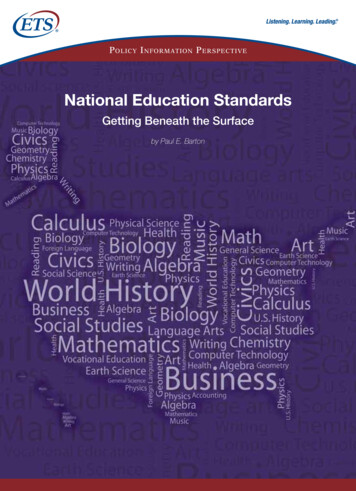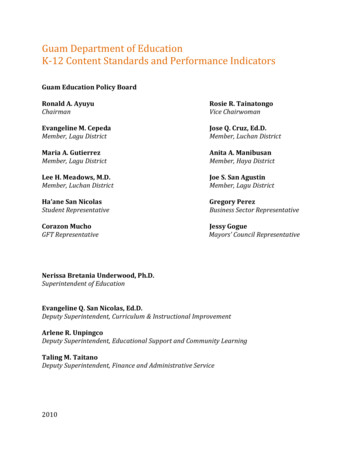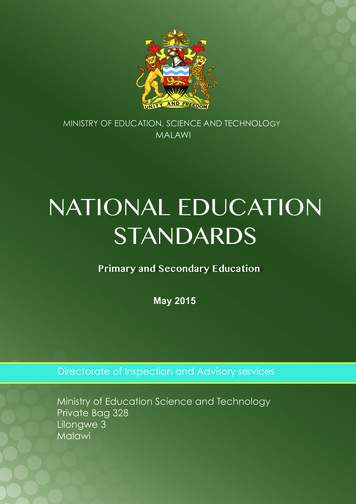
Transcription
P olicy I nformation P erspectiveNational Education StandardsGetting Beneath the Surfaceby Paul E. Barton
Additional copies of this report can beordered for 10.50 each (prepaid) from:Policy Information CenterMail Stop 19-REducational Testing ServiceRosedale RoadPrinceton, NJ 08541-0001(609) 734-5949e-mail: pic@ets.orgCopies can be downloaded for free at:www.ets.org/research/picCopyright 2009 by Educational Testing Service. All rights reserved. ETS, the ETS logo and LISTENING. LEARNING. LEADING. are registeredtrademarks of Educational Testing Service (ETS). AP, Advanced Placement and Pacesetter are registered trademarks of the College Board. EducationalTesting Service is an Affirmative Action/Equal Opportunity Employer. 11215June 2009
Table of ContentsPreface. 2Acknowledgments. 2Introduction. 3Where We Have Been. 5The Current Conversation About National Standards. 7What Does Setting National Standards Mean?. 9Some Recent Developments.10Recognizing the Wide Variation in the U.S. Education System.13Variation in Content.13Variation in Performance Standards.15Variation in Student Achievement.19The Importance of Widespread Variation in Achievement to the National Standards Discussion.23Who Bears Responsibility for Meeting Standards?.25Facing Choices, Risks, and Difficulties.28 Relationships Between the Call for National Standards andExisting Test-based Accountability.28Assessing the Benefits of Local and State Responsibility.28Recognizing Continuing Conflicts.29Creating a National Standards System.31What to Do?.32Learning from Experience.32Finding What’s Feasible and Useful.33Curriculum Standards and “Standardization”.34An Alternative to Consider.35The One-Size-Fits-All Question.36Standards for Course Titles?.36Getting More Out of the Current National Efforts.38Concluding Comments.40
PrefaceEstablishing national standards for whatshould be taught in schools along with a testto measure if the standards have been met havebeen debated and tried to varying extents over thelast quarter century. Each time, the investmentin high-level commissions and commissioneddevelopment work has ended in inaction.Controversy over the effectiveness of the NoChild Left Behind Act (the federal government’smajor influencer of state education behavior),the persistence of achievement gaps, and concernabout our international competitiveness haveresulted in new efforts to establish national orcommon standards. Some advocate for nationalstandards to be developed and implementedoutside of the federal government, while othersare pushing for federal legislation.While the public discussions have beenongoing for quite a while, they gained newmomentum since the presidential election of2008 and the anticipation of a reauthorizationof the No Child Left Behind Act.This report, authored by Paul E. Barton,is written with the objective of increasing ourunderstanding of the history, the facts, thechoices, the risks, and the possibilities thatare relevant in coming to a decision aboutestablishing national standards in a nation thathas built its education system from the bottomup and has prized local control of the schools.Barton makes clear that the report’s purposeis to inform, rather than oppose or advocate aparticular course of action. It also is clear thathe thinks the considerations are many, and thatcomplexities abound. Nevertheless, he offers anumber of approaches that might be consideredfor increasing commonality in what is taught, andpresents examples and experiences that are beingtried across the nation, and might be built uponin moving in this direction. While the report isnot a “yes” or a “no” about uniform nationalstandards, the clear message is that anyone whowants to make a sound and reasoned judgment onthe question needs to do much homework first.This report will help with that.Michael T. NettlesSenior Vice PresidentPolicy Evaluation and Research CenterAcknowledgmentsAnumber of people provided helpful reviewsof this report. They include Richard Coley,Christopher Cross, Emerson Elliott, DrewGitomer, John Jennings, Mark Musick, MichaelPetrilli, W. James Popham, Richard Rothstein,2 National Education Standardsand Charles Smith. Not all reviewers wouldnecessarily agree with all of the conclusionsdrawn. Janet Levy and Eileen Kerrigan were theeditors. Marita Gray designed the cover and SallyAcquaviva provided desktop publishing services.
IntroductionThe education reform movement didnot begin with a call for national orfederal action, but for action among schools,districts, and states. That call, sounded byrecommendations in the 1983 A Nation At Riskreport, came from the National Commissionon Education Excellence (NCEE) — at a timewhen President Reagan advocated the abolitionof the new Department of Education. Againstthis backdrop, a strong national education policyappeared unlikely.Although much transpired at lower levels toimplement the NCEE report’s recommendations,underneath the surface brewed a desire for actionat the top. So began a period of high-level actioncaught in a start-stop loop, but never gainingclear-cut momentum.By the beginning of the 21st century, strongaction was taken at the federal level. This camein the form of the No Child Left Behind (NCLB)Act, which specified what states had to doregarding raising student achievement andimproving the quality of teaching. While NCLBnow has an unknown future, it has illuminatedthe issue of national education standards. The acthas renewed in many a thirst for such standardsand rekindled in others an aversion to them.This report will discuss issues involved in thedebate over whether the United States shouldhave national education standards, what mustbe considered in creating such standards, whatproblems must be addressed, and what trade-offsmight be required among conflicting objectives.The hope is that posing questions and providingrelevant information will help clarify thinkingabout this topic.The first section provides a short summary ofdevelopments in education over the past couple ofdecades. The current movement toward commonstandards has not suddenly appeared, but comeswith a history of starts and stops — evidence thata clear and lasting consensus has not yet emerged.Next follows information about who has beensaying what about bringing national standardsinto existence; then, what advocates anddetractors mean when they talk about standards.Often, their meanings differ.Many people have indeed given seriousthought to the standards issue, and collaborationshave developed to find commonality. This reportsummarizes progress on that front.The “Recognizing Variation” section picks upon one of the hot topics of today. Underlyingthe effort for standards and commonality isan understanding of the significant variationsnationwide in curriculum, content, andassessment quality. This report addresses threedistinct kinds of variation: content/curriculum,performance standards, and student achievement,the latter of which is typically expressed in termsof a cut-score on a test.Discussions of standards have not alwaysidentified which set of variations are beingaddressed, thereby not fully identifying whatneeds fixing. Comprehending the complexity ofall three variations is important to the standardsdiscussion, as differences within each type canbe extraordinary.Finally, this report advances some of thechoices that need to be made, risks that thosechoices will entail, and difficulties that will beinvolved in achieving common standards. Manyof these issues arise from the country’s longhistory of building its education system from theground up and at the local level, as well as fromthe great diversity of local and state populationsand their economies.National Education Standards 3
An important question is: How shouldthe country get started? How can it create anentity that sets standards and gains widespreadacceptance? This report presents some thoughts,particularly on the topic of finding a processthat could lead to standards reaching arecognized legitimacy.Providing a clear set of answers is beyondthe capabilities of this author, but this reportexplores a few avenues for moving towardgreater commonality. Included are thoughts ongaining more from the National Assessment ofEducational Progress (NAEP), which has seenexpanded use over the past 25 years.4 National Education StandardsOverall, the hope of this report is a modestone: that readers will increase their knowledge onthe topic and will gain a clearer understanding ofwhat is possible and desirable.
Where We Have BeenFor historical context on education standards,four references are recommended: NationalStandards in American Education: A Citizen’sGuide, by Diane Ravitch (Brookings InstitutionPress, 1995); Why National Standards and Tests?,by John F. Jennings (Sage Publications, 1998);Political Education: National Policy Comes of Age,by Christopher Cross (Teachers College Press,2004); and “Standards Based Reform: A PowerfulIdea Unmoored,” by Lauren Resnick, et al., inImproving on No Child Left Behind, edited byRichard D. Kahlenberg (Century FoundationPress, 2008). These sources better equip readersto consider what might be avoided, what mightbe repeated, and what might be the prospects fornew national standards efforts in the future.The first salvo on national standards didnot come from the government. In 1989, theNational Council of Teachers of Mathematics(NCTM) published a set of standards forteaching mathematics, based on consensus frommany teachers and mathematics experts. FormerColorado Governor Roy Romer, who headedthe National Education Goals Panel, said thesestandards exemplified what needed to be done inother subject areas.Indeed, the NCTM standards did serve asa model for similar efforts in other subjects,initiated by and funded under the leadershipof Diane Ravitch, an assistant Secretary ofEducation in the administration of PresidentGeorge Herbert Walker Bush. President Bushfirst set the education agenda when, in 1989,he convened the nation’s governors at aneducation summit in Charlottesville, Va.Emerging from this conference was a set ofnational goals to be reached by 2000 — thusmarking an era of collaboration.1Ravitch’s efforts, meanwhile, concernedrigorous content rather than standardized testsand accountability, with voluntary standardscreated in science, history, geography, foreignlanguages, the arts, English, and civics in 1991and 1992. These standards served as startingpoints for many states who wished to createtheir own.A rather large and extended effort towardnational standards was the several-faceted America2000 program, which engaged communitiesthrough citizen-run committees. In the Houseand Senate, this program also provokedgreat discussion.Different ideas emerged. Equity concernsarose, and what came to be called the“opportunity to learn standards,” as well as theissues of “choice” and of private-school vouchers,became sources of argument. As John Jenningssummarized: “ the contention surrounding thatissue [opportunity to learn standards] was to delaythe legislation so long and cause so much ill willthat it ultimately killed the bill.”1Meanwhile, Secretary of Education LamarAlexander — with the approval of Congress— urged the bipartisan National Council onEducation Standards and Tests to “advise on thedesirability and feasibility of national standardsand tests.”The council’s 1992 report recommendednational content standards and assessmentsbased on these standards, but did not advocatea national test. The report set out criteria forcreating content standards, recommending thatthe standards be national but not federal, andstating that they were not to become part of a“national curriculum.” John F. Jennings, Why National Standards and Tests?, Sage Publications, 1998.National Education Standards 5
But the report also introduced the idea of“national delivery standards,” something thatreceived a lot of attention and was the focusof great disagreement. The premise was this: Ifstudents were to be held accountable for meetingthe standards as measured by the tests, assurancewas needed that instruction would give studentsthe “opportunity to learn” the content.The Clinton administration’s Goals 2000legislation was the next foray into nationalstandards. In 1994, the National EducationStandards and Assessment Council wasauthorized, as recommended in the NationalCouncil on Education Standards and Tests report,but never established. Again, much debate andcontroversy ensued.The Clinton administration proposed creationof voluntary national tests in fourth-grade readingand eighth-grade math. The National AssessmentGoverning Board (NAGB), which oversees NAEP,was to manage execution of the tests. Much workwas done, including developing a “framework” toguide test construction and constructing actualtest items. Hearings on the issue were held aroundthe country, but the effort eventually dissolveddue to lack of funding.6 National Education StandardsAlso in 1994, amendments to the Elementaryand Secondary Education Act (ESEA) of 1965required states to establish content standards,tests to measure student achievement in thesestandards, and performance standards. Standardswere still popular, and federal involvement wasacceptable — but only as far as saying what hadto happen in the states, rather than in somenational or federal entity.The nation’s governors and business leaderscreated the nonprofit organization Achieve towork with states in carrying out a standards-basedreform agenda. Achieve has become an importantorganization, both in helping states improvetheir standards and in gaining collaborationaround shared objectives. Given its agenda andexperience, Achieve is likely to play a significantrole in any further movement toward commonnational standards.In 2001, through the NCLB Act, the federalgovernment took previous efforts a giant stepfurther. It began using the cut-points on stateachievement tests, which represented attainmentof “proficiency,” as the cornerstone of a test-basedaccountability and sanctions system for states. Atthis writing, the country is on the precipice of aturning point with the NCLB-reauthorizationquestion looming over Congress and theObama administration.
The Current ConversationAbout National StandardsAlthough the nation has been up the standardshill and down the other side over the pasttwo decades, some strong voices urge still anothertrip up the hill. Movement toward collaboratingon standards setting is gaining traction, and somethoughtful efforts have taken place to examine theproblems and possibilities.These are briefly referenced below and will bementioned again later: Some well-known leaders — including formerNorth Carolina Governor James Hunt, formerIBM board chairman Louis V. Gerstner Jr.,former Colorado Governor Roy Romer, andothers — have long been strong advocates,arguing that the nation is in crisiswithout standards. Former Secretaries of Education WilliamJ. Bennett and Rod Paige have argued thatnational standards and a national testare needed. In 2006, Chester Finn Jr., Liam Julian, andMichael Petrilli issued To Dream the ImpossibleDream, published by the Thomas B. FordhamFoundation, with a dozen well-regardedcontributors. This thoughtful effort laid out“Four Approaches to National Standards andTests for America’s Schools” and provided arange of levels of developments and nationalinterventions (more detail is provided later).In fall 2008, the Fordham Foundation held adebate on national standards.2 Education Daily, July 18, 2008.3 Education Week, June 10, 2008.4 Education Week, June 10, 2008. Education Sector sponsored “A Debate onNational Education Standards” in 2006. Theproceedings are summarized in “Five ExpertsSquare Off,” ES Review, fall 2006. In 2007, the Nelson A. Rockefeller Instituteof Government held a conference thatproduced the transcript publishedin Intergovernmental Approaches forStrengthening K-12 Accountability Systems. A July 2008 edition of Education Daily states:“A group of big city school superintendentsaddressed Congress on Thursday to retainaccountability provisions in a reauthorizationof NCLB, and counseled a move toward growthmodels and national standards. Arne Duncan,CEO of Chicago Public Schools, urged legislatorsto ‘set a uniform achievement standard but allowstates flexibility in meeting it.’”2 In 2007, U.S. Secretary of Education MargaretSpellings argued that “the debate over nationalstandards would become an exercise in lowestcommon-denominator politics” and would notnecessarily improve the content of schooling.3 In 2007, the National Conference of StateLegislatures voted to reject the idea of commonstandards, saying, “We need rigorous statestandards that are anchored in real-worlddemands.”4 In October 2008, the James B. Hunt Institutefor Educational Leadership and Policy set out a“Blueprint for Education Leadership.”National Education Standards 7
The National Research Council of the NationalAcademies held a series of workshops toanalyze prospects, procedures, alternatives,and problems related to national standards.The most in-depth effort to grapple with bothoverall objectives and details of the problems,the workshops produced the 2008 summaryreport Common Standards for K-12 Education?Considering the Evidence.5Although many statements seem to supporttaking action, most are sparse on the detailsof what to do and how to do it, as backed bysolid analysis. However, the above-mentioneddocuments provide excellent starting points forthe discussion on national action relatedto standards. By March 2009, the National GovernorsAssociation, the National Association ofSecondary School Principals, the Councilof Great City Schools, and the AmericanFederation of Teachers (AFT) all publiclysupported national standards.65 National Research Council, Common Standards for K-12 Education?: Considering the Evidence, Washington, D.C.: National Academies Press, 2008.6 David Hoff, Education Week, March 4, 2009.8 National Education Standards
What Does SettingNational Standards Mean?Concepts for imposing national educationstandards range from a general propositionthat all schools help students achieve somecommon degree of learning, to a moresophisticated proposal that “content standards”be established and evaluated in periodic surveys,such as those carried out by the AFT and by theFordham Foundation.The rigor and quality of existing state standardsvary greatly, and states have different mindsetsabout what content standards are intended to do.One state may see standards as an expression ofhigh aspirations for how much students shouldknow. Another state may view standards as a wayto make realistic judgments about what is possiblefor students to know, given that state’s experiencewith its schools. Still another state, seeing testsdesigned to measure school effectiveness andto trigger sanctions, may set modest standardsto ensure perceived success. These and otherdifferences in thought and approach surelycontribute to the wide differences revealed inevaluations of the states.Once a state determines what the standardsshould do, it must decide how demanding tomake them. Before doing this, those creatingstandards must understand how wide thedistribution of achievement is in that state’sschools in any one grade. For example, wherethe spread of achievement is wider — perhaps asmuch as three grade levels from the bottom tier tothe top — setting a single performance standardbecomes problematic.Some serious advocates of national standardshave thought principally in terms of a morerigorous curriculum. This mirrors the modeladvocated by Diane Ravitch and the NCTM inthe late 1980s.7Many advocates of national standards wantsuch content standards, and a standardized testbased on those standards. Others prefer to jumpto the proposition that a good national test isneeded, period. The most general belief is that a“good” set of content standards can be fashionedand that it is possible to determine the level ofstudent performance from standardized testing.This may be achievable, but given the nation’sunwillingness to invest in high-quality assessmentsthat go beyond filling in the bubbles, this ideafaces many hurdles.Lauren Resnick, a leading authority onstandards and assessments, summed it up thisway: “The tests are not aligned to their ownstate standards in all but a very few cases. Most of the state tests do not test the high level,intellectual demands that we were after when weset up the standards.”7Those who focus primarily on a standardizedtest do so because it provides test scores fora sanctions-based accountability system ina way that simply describing course contentdoes not. For example, in the aforementionedRockefeller Institute of Government conference,the morning agenda was “Models for SettingAcademic Standards” and the afternoon agendawas “Approaches to Testing Oversight andAccountability” — yet, most of the morningsession addressed testing, and the afternoon wasall about testing.Another key question is whether nationalstandards should be voluntary. Should theyserve merely as useful models or as mandatoryprinciples, enforced through the Elementary andSecondary Education Act or other legislation?Before the country can seriously consider nationalstandards, it must seriously address these difficultquestions around the topic. Lauren Resnick, “Five Experts Square Off,” Education Sector Debates, 2006.National Education Standards 9
Some Recent DevelopmentsThe education system is largely a publicorganism operating in the public sector:created, funded, controlled, and administered bya local government, under a state constitutionand state laws, with some financial support andrequirements under federal law. Governmentaland law agencies impose existing standards bydefining a curriculum’s content, administeringtests to see if students know the content, andapplying incentives or sanctions accordingly.Before NCLB, many states provided bothincentives and sections based on tests. WhenNCLB was passed, the new law simply used thecut-points designated as representing “proficiency”on these tests as a basis for applying sanctions.However, after the law passed, states were free tochange their cut-points.Much of the discontent with NCLB has beenover the large variation in these state-set cutpoints. Although many states have set what areconsidered low cut-points, former Secretary ofEducation Spellings has stated that creating anationwide cut-point will only perpetuate theproblem, likely establishing a single standard thatis too low.Considerable discussion has taken placearound how to establish collaboration outside thefederal government to set education standards,how to shape that effort, and how ambitiousto make it. In 2006, the Thomas B. FordhamFoundation published To Dream the ImpossibleDream: Four Approaches to National Standardsand Tests for America’s Schools. The 44-page workincluded contributions from a dozen well-knownpeople in the field, including Chester E. FinnJr., Liam Julian, and Michael J. Petrilli. A wellattended forum followed in Washington, D.C.10 National Education StandardsThe four approaches offered and discussed areas follows:1. The Whole Enchilada. The federal governmentimposes standards on the states, and standardsare used for accountability. The FordhamFoundation concluded that this approach wasnot politically feasible. On the merits of thisapproach, forum participants had varied views.2. If You Build It, They Will Come. This isa voluntary version of the first model, withthe federal government or a private groupdeveloping standards and providing incentives.Contributors judged this approach “maybe”politically feasible.3. Let’s All Hold Hands. Through this approach,states are encouraged to join one another indeveloping common standards, possibly with thefederal government providing incentives, but nomore. Contributors also judged this approach“maybe” politically feasible.4. Sunshine and Shame. Called the “leastambitious model,” this approach ensures thatstate standards and tests are “more transparent”by making them easier to compare with oneanother and with NAEP. Contributorsconsidered this approach feasible.Some of the same people gathered in Chicagoin 2007 with Richard Nathan and the Nelson A.Rockefeller Institute of Government to consider theaforementioned “Intergovernmental Approachesfor Strengthening K-12 Accountability Systems.”The edited and published transcript includes aframework paper written by Allison Armour-Garbof the Rockefeller Institute and distributed toconference participants.
Discussions among the 37 participants werebroad and far ranging, but informed morethan they concluded. The Rockefeller Institutepromised to use the proceedings for a furthereffort and to produce a new paper.Any effort to move forward on nationalstandards will benefit greatly from recent workof the National Research Council (NRC) of theNational Academies. The United States has nomore respected source of scientific knowledgeand research than the NRC, which conducted aseries of workshops and summarized the results inits 2008 publication Common Standards for K-12Education?: Considering the Evidence.The following is a list of topics covered in theNRC publication, which will be revisited later inthis report: the degree of variability in content andperformance standards and in “paradoxes,”including views from five states a description and consideration of availableoptions analysis of the quality of content standards andof their impact on teaching and learning estimated costs political and legal considerations perspectives of researchers and elected officialson implementation of common standardsIt is hard to read the NRC report carefullyand not come away with an understanding of theimportant questions, needs, and considerations offeasibility and desirability around standards.In a November 2008 paper titled The Roleof Assessment in Federal Education Programs,commissioned by the Center on EducationPolicy, W. James Popham provides a “serviceableframework for rethinking an appropriate federalrole in U.S. educational testing.”Popham addresses what role the federalgovernment should have, what the measurementmissions of tests should be, and five gradientsof federal involvement, ranging from zero tototal federal control. With an academic careerin educational measurement, Popham for yearshas been analyzing and regularly writing andpublishing on what has been happening duringthe standards-based reform and test-basedaccountability period. His paper includes a reviewof the federal role over the past 50 years.The organization Achieve has made the longestcollaborative effort, with the widest reach. Achieveis the result of a joint endeavor among the nation’sgovernors, chief state school officers, and CEOs oflarge corporations, informed by earlier efforts thatcreated the National Education Goals Panel.Another base of experience is the New EnglandCommon Assessment Program (NECAP),through which New Hampshire, Rhode Island,and Vermont are implementing a commonstandards-and-assessment program. A principalincentive for these three small Northeast states isthe considerable amount of money they can savethrough collaboration. While the cost of havingseparate standards has not yet motivated theremaining states, the recession of 2008 – 2009may help push more of them to work together.Achieve, the National Governors Associa
National Education Standards 3 Introduction T he education reform movement did not begin with a call for national or federal action, but for action among schools, districts, and states. That call, sounded by recommendations in the 1983 A Nation At Risk report, came from the National Commission on Education Excellence (NCEE) — at a time










